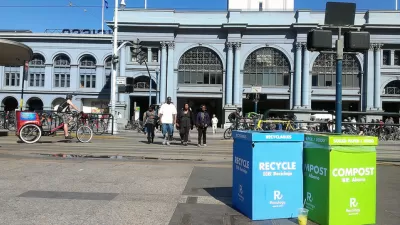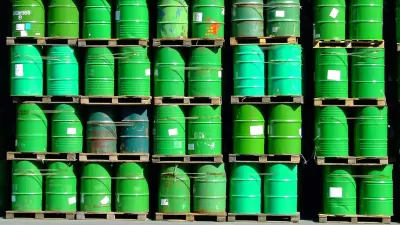Research has shown that the world's largest land use, grazing, holds enormous potential when linked with composting, to dramatically reduce the carbon content of the atmosphere through sequestration while concurrently restoring degraded rangeland.
The largest component of solid waste—food waste (according to this EPA pie chart)—may be one of the most effective tools to fight climate change if municipally composted and applied on rangeland as San Francisco has been doing since 2009. However, they don't have much company.
"In 2010, 97% of America's 35 million tons of food waste went into landfills," as noted here last year, Plus, we also pointed out here last year that according to "a new study from the U.N. Food and Agriculture Organization, food waste Is third-largest greenhouse gas source."
"The research showed that if compost from green waste — everything from household food scraps to dairy manure — were applied over just 5 percent of (California)'s grazing lands, the soil could capture a year’s worth of greenhouse gas emissions from California’s farm and forestry industries," writes Carolyn Lochhead of the San Francisco Chronicle.
Experiments on grazing lands in Marin County and the Sierra foothills of Yuba County by UC Berkeley bio-geochemist Whendee Silver showed that a one-time dusting of compost substantially boosted the soil’s carbon storage.
The application of compost helps "(p)lants pull carbon dioxide from the air through photosynthesis and transfer a portion of the carbon to the soil through their roots." Ohio State University provides a more elaborate description under the "Carbon and Soil Organic Matter" section of their factsheet [PDF].
"Grazing is the single largest land use on the planet, and most grazing lands are degraded, meaning they have lost carbon," writes Lochhead. "That includes California’s coastal and Sierra foothills, where invasive plant species have displaced native perennials that have much deeper roots and store much more carbon."
The University of North Dakota Energy & Environmental Research Center describes the "two major types of CO2 sequestration: terrestrial and geologic:"
- Geologic sequestration is putting CO2 into long-term storage in geologic zones deep underground. It is the method of storage that is generally considered for carbon capture and storage (CCS) projects [from anthropogenic carbon sources].
- Terrestrial (or biologic) sequestration means using plants to capture CO2 from the atmosphere and then storing it as carbon in the stems and roots of the plants as well as in the soil.
"Enter the city of San Francisco, which composts 700 tons of residential and commercial organic waste every day, the largest such operation in the world," writes Lochhead.
“I’ve been in the recycling business for 30-some years here in San Francisco, and this just was much more transformative than the various things we were trying to do to stop putting carbon into the atmosphere,” said Kevin Drew, zero-waste coordinator for San Francisco’s Department of Environment. “To turn around and start taking it out of the atmosphere was a really revolutionary idea, particularly when it was as simple as putting compost on rangeland.”
Composting as a climate mitigation strategy has attracted the attention of "the American Carbon Registry, an organization that certifies (carbon) offsets in California’s cap-and-trade system. On (Oct. 18), it approved one for compost additions to rangeland."
FULL STORY: A sprinkle of compost helps rangeland lock up carbon

Planetizen Federal Action Tracker
A weekly monitor of how Trump’s orders and actions are impacting planners and planning in America.

Map: Where Senate Republicans Want to Sell Your Public Lands
For public land advocates, the Senate Republicans’ proposal to sell millions of acres of public land in the West is “the biggest fight of their careers.”

Restaurant Patios Were a Pandemic Win — Why Were They so Hard to Keep?
Social distancing requirements and changes in travel patterns prompted cities to pilot new uses for street and sidewalk space. Then it got complicated.

Platform Pilsner: Vancouver Transit Agency Releases... a Beer?
TransLink will receive a portion of every sale of the four-pack.

Toronto Weighs Cheaper Transit, Parking Hikes for Major Events
Special event rates would take effect during large festivals, sports games and concerts to ‘discourage driving, manage congestion and free up space for transit.”

Berlin to Consider Car-Free Zone Larger Than Manhattan
The area bound by the 22-mile Ringbahn would still allow 12 uses of a private automobile per year per person, and several other exemptions.
Urban Design for Planners 1: Software Tools
This six-course series explores essential urban design concepts using open source software and equips planners with the tools they need to participate fully in the urban design process.
Planning for Universal Design
Learn the tools for implementing Universal Design in planning regulations.
Heyer Gruel & Associates PA
JM Goldson LLC
Custer County Colorado
City of Camden Redevelopment Agency
City of Astoria
Transportation Research & Education Center (TREC) at Portland State University
Camden Redevelopment Agency
City of Claremont
Municipality of Princeton (NJ)




























